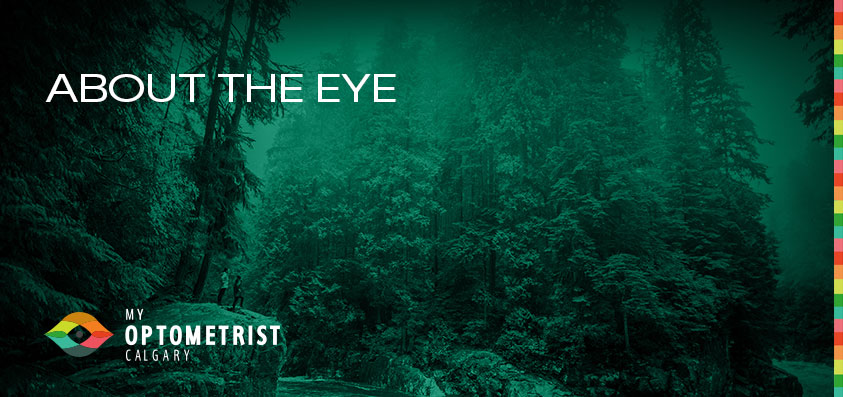

An adult eye is about one inch (or 25 mm) in diameter. It resides in an area of the skull called the orbit, which visibly reveals only one-sixth of the eye. The eyelids, eyelashes and eyebrows are ocular features that protect this exposed area of the eye from strong light, dust particles, and foreign stimuli. The outermost section, or the white part of the eye, is responsible for giving it support and shape. This is known as the sclera. A thin, mucous layer called the conjunctiva, lines the inside of the eyelids and covers the exposed portion of the sclera.
The sclera connects to a clear dome-shaped layer called the cornea, which controls the amount of light that enters the eye. From the cornea, the light is passed through the pupil. The pupil is the dark opening in the centre of the iris, which is pigmented and gives the eye its colour.
Apart from its ability to generate eye colour, the iris functions as a diaphragm, which causes the pupil to expand or contract when adjusting to different light intensities: getting smaller in bright light and larger in dim light.
Located behind the iris, is our natural lens. The lens changes shape to assist the cornea in focusing and directing light onto the retina. The retina is the light-sensitive tissue that lines the inner walls of the eyeball. Most of the eye’s central interior is filled with a gel-like substance, the vitreous, which supports its rigid shape.
The eye has many functions to protect our sight.
Our eyes work much like a camera, with highly developed structures dedicated to each part of the sophisticated vision system.
An adult eye is about one inch (or 25 mm) in diameter. It resides in an area of the skull called the orbit, which visibly reveals only one-sixth of the eye. The eyelids, eyelashes and eyebrows are ocular features that protect this exposed area of the eye from strong light, dust particles, and foreign stimuli. The outermost section, or the white part of the eye, is responsible for giving it support and shape. This is known as the sclera. A thin, mucous layer called the conjunctiva lines the inside of the eyelids and covers the exposed portion of the sclera.
The sclera connects to a clear dome-shaped layer called the cornea, which controls the amount of light that enters the eye. From the cornea, the light is passed through the pupil. The pupil is the dark opening in the centre of the iris, which is pigmented and gives the eye its colour.
Apart from its ability to generate eye colour, the iris functions as a diaphragm, which causes the pupil to expand or contract when adjusting to different light intensities: getting smaller in bright light and larger in dim light.
Light information is collected and processed in the retina and then passed in the form of electrical signals. The macula, the central area in the retina, is responsible for our most acute vision. These signals, processed by the retina, are delivered directly to the brain through the optic nerve. Thereafter, the visual information is interpreted by the brain.
Connect With Us Today!
Our Eye Care Professionals are thrilled to serve the Calgary and Three Hills, Alberta area for over 35 years! With our main floor access, vast medical eye care services, and enhanced supplier choice and selection for frames, prescription eyeglass lenses and contact lenses, we've got you covered. Book an appointment online, come see us in person, or shop for your eye care products. Reach out today!